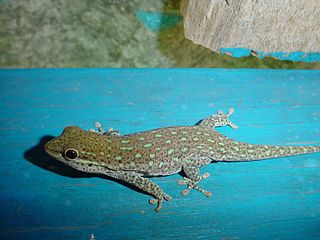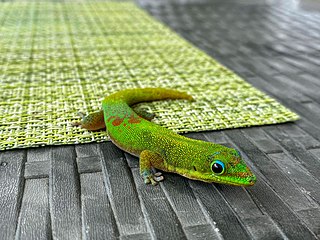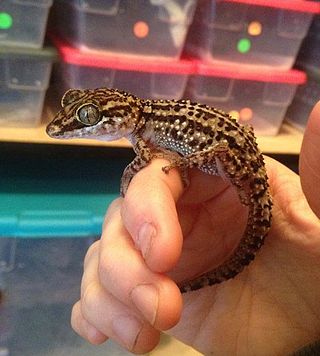
Phelsuma dubia, also known as dull day gecko, olive day gecko, Zanzibar day gecko or green day gecko, is a diurnal species of gecko. It is about 15 centimetres (5.9 in) in length and lives on the western coast of Madagascar, in the Comoros, and the coast of East Africa. It typically inhabits trees and can also be found near human dwellings. The Dull day gecko feeds on insects and nectar.
Agalega day gecko is a subspecies of geckos.

Phelsuma breviceps is a diurnal species of gecko that is native to south-west Madagascar and typically dwells on trees and bushes. Its diet in the wild consists mainly of insects.

The speckled day gecko is a diurnal species of geckos. It lives in eastern Madagascar and typically inhabits rainforests and dwells on trees. The speckled day gecko feeds on insects and nectar.
Phelsuma laticauda angularisMertens, 1964 is a diurnal subspecies of geckos. It lives in northern Madagascar and typically inhabits different trees and houses. The Gold dust day gecko feeds on insects and nectar.

The flat-tailed day gecko is a diurnal gecko lives in eastern Madagascar. It is endangered due to illegal collection for the international pet trade. It typically inhabits rainforests and dwells on trees. The flat-tailed day gecko feeds on insects and nectar.

Pasteur's day gecko is a small diurnal subspecies of gecko. It lives in the Comoros and typically inhabits trees and bushes. Pasteur's day gecko feeds on insects and nectar.

Phelsuma v-nigra v-nigraBoettger, 1913 is a small diurnal subspecies of geckos. It lives in the Comoros and typically inhabits trees and bushes. Phelsuma v-nigra v-nigra feeds on insects and nectar.

The Grand Comoro Day Gecko is a small diurnal subspecies of geckos. It lives in the Comoros and typically inhabits trees and bushes. The Grand Comoro day gecko feeds on insects and nectar.

The Anjouan Island day gecko is a small diurnal subspecies of gecko. It lives in the Comoros and typically inhabits trees and bushes. The Anjouan Island day gecko feeds on insects and nectar.

Mauritius ornate day gecko is a diurnal species of gecko. It occurs on the island of Mauritius and some surrounding islands and typically inhabits different trees and bushes. The Mauritius ornate day gecko feeds on insects and nectar.

Phelsuma pronki, also known as Pronk's day gecko, is a critically endangered diurnal species of gecko, a lizard in the family Gekkonidae. The species is endemic to central Madagascar, and threatened by severe habitat loss and collection for the international pet trade. It typically inhabits rainforests, dwells on trees, and feeds on insects and nectar.

The tokay gecko is a nocturnal arboreal gecko in the genus Gekko, the true geckos. It is native to Asia and some Pacific Islands.

Cyrtodactylus deccanensis, also commonly known as Deccan ground gecko, Günther's Indian gecko, or the banded ground gecko, is a species of gecko found in the northern Western Ghats of India. It has been found from northern Maharashtra, with a habitat range possibly extending to southern Gujarat. Cyrtodactylus albofasciatus was previously considered conspecific with Cyrtodactylus deccanensis but is now accepted as a valid species.

The tropical house gecko, Afro-American house gecko or cosmopolitan house gecko is a species of house gecko native to sub-Saharan Africa. It is also currently found in North, Central and South America and the Caribbean, where it has been inadvertently introduced by humans.

Duvaucel's gecko is a species of lizard in the family Diplodactylidae. The species is endemic to New Zealand.

The common house gecko is a gecko native to South and Southeast Asia as well as Near Oceania. It is also known as the Asian house gecko, Pacific house gecko, wall gecko, house lizard, tiktiki, chipkali or moon lizard.

The dubious dtella, native Australian house gecko, or dubious four-clawed gecko is a species of gecko in the genus Gehyra, native to Northeastern Australia. The lizard is found in a variety of habitats, including acacia and eucalyptus woodlands, and in human-developed habitats, such as house walls in urban areas. Its urban presence makes it known as a common house gecko in Queensland. These geckos are often confused with the Asian common house gecko, which was introduced to Australia from Indonesia, but G. dubia has distinct rounded feet and quieter calls.

Paroedura lohatsara is a species of small-to-medium-sized geckos native to northern Madagascar where it is found on a single mountain range. These geckos are up to 6 cm (2.4 in) long and are brown with black speckling, the speckles sometimes combining into longitudinal bands. Juveniles have wide transverse bands of black and transition into the adult colouring as they grow. This gecko is mainly nocturnal and is found on the ground, on boulders and in the lowest branches of trees. Because of its limited range and the ongoing destruction of its forest habitat, this species is listed as critically endangered on the IUCN Red List. It is not currently protected under CITES. Some individuals are kept in captivity in the United States and may act as a genetic resource if the gecko becomes extinct in the wild.
This page is based on this
Wikipedia article Text is available under the
CC BY-SA 4.0 license; additional terms may apply.
Images, videos and audio are available under their respective licenses.
















